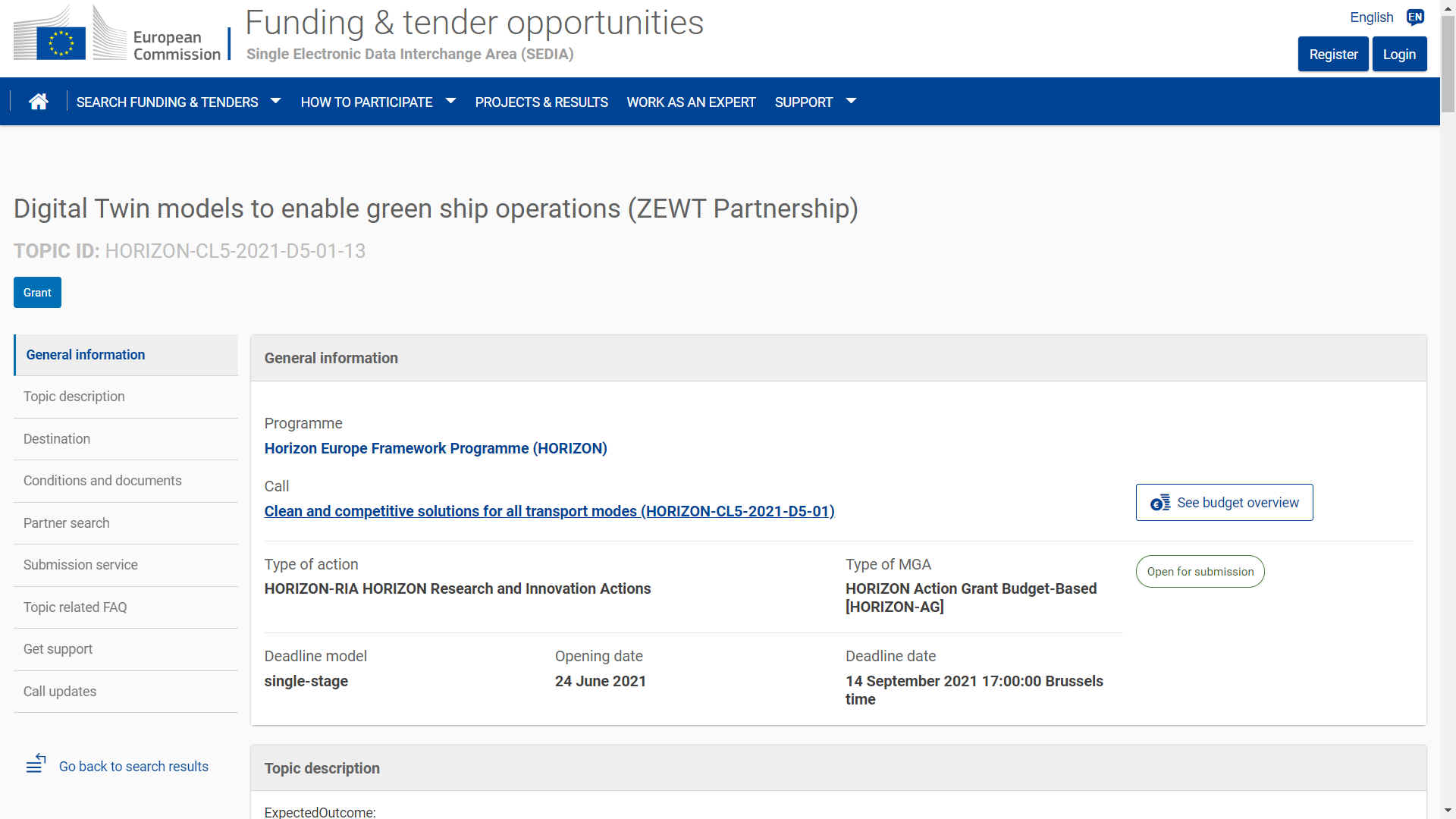|
2021-2022
MARITIME – ZEWT TOPICS - DEADLINE 7th SEPTEMBER 2021
Type of Action: Innovation Action (RIA)
TRL:
5
Expected EU contribution per project (M€) = €20m
Number of projects to be funded = 1 @ €7 million
ZEWT Partnership – Zero Emission Waterborne Transport
EXPECTED OUTCOME:
Project outputs and results are expected to contribute to all of the following expected outcomes:
- Reduced emissions and improved efficiency enabled through development of digital models and tools for a wide range of vessel types, ship systems and operational environments.
-
Prove and quantify the impact regarding emissions reductions and improved efficiency through productivity and performance increases based on a proven and efficient environmental impact assessment methodology.
-
Ensuring the wider applicability of digital models for different ship types, both for new constructions and for retrofitting, through a comprehensive methodology and a transferable system architecture.
-
Proving the interoperability of data models between different ship types and regarding the link with port digital twin models.
-
Benchmarking efficiency improvements against other industry sectors.
-
Increase the confidence of investors concerning the expected improvements in energy efficiency and reduced emissions resulting from upgrades and modifications for both new designs and retrofitting.
-
In the medium term, enable the development of the “zero emission decision support system” as a contribution to the 55% reduction goals of fuel consumption in 2030.
SCOPE:
The digital revolution is affecting most industrial sectors, enabling the digital modelling of designs, manufacturing processes and operations. A wider and better development of Digital Twin (DT) models enables new functionalities for the design and operation of vessels to improve operational efficiency to be developed and validated with increased confidence without resorting to more costly physical testing. DT modelling can be founded and validated using sensor data, data mining and merging, big data,
AI and self-learning to improve efficiency on all levels. Such developments increase owner confidence in the expected performance when procuring innovative green systems as well as providing operational feedback to the manufacturer which can be used to further improve energy efficiency. In this respect DT models are understood as wide-ranging tools with known application areas and those still to be explored.
The waterborne (transport) sector is characterised by very diverse requirements and market realities. Ships, their systems and related technical and commercial processes are already widely using digital technologies including virtual models but those are generally developed individually and with significant overlaps. Capital expenditure is often very high. The wider implementation and integration of digital technologies into more coherent Digital Twins on-board and onshore supporting user oriented decisions is still in its infancy.
Whilst simulation environments are relatively mature maritime system tools, development to enable full exploitation of the potential functionalities is still lacking.
Activities will address the DT concept in order to improve energy efficiency and environmental performance from the early design phase of vessels to the end of the life cycle, thus providing assurance to the owner or operator concerning the expected improvements resulting from upgrades and modifications. This will be a key factor to achieve the
zero-emission targets for waterborne transport, while increasing the understanding of vessel performance in a wide range of operations, in particular in the view of the parallel uptake of a multitude of innovative technologies for on-board energy storage, distribution and conversion as well as those for
voyage optimisation and manoeuvring. A methodology to assess environmental impacts and performance improvements through the DT model should be developed and validated, with the definition of KPIs orienting the design choices and manufacturing processes.
Project(s) will develop DT models, preferably based on existing specifications and simulation environments, addressing different ship systems (e.g. engine and machinery operations, hull/propeller performance and interaction models, electric network management including in particular HVAC, cargo handling) in order to have a significant impact on energy efficiency as well as on operational performance, both in maritime transport and IWT and with regard to newbuildings and existing vessels. To this end the dynamic use of real life data (feedback loop) is expected to be addressed as well.
This topic implements the co-programmed European Partnership on ‘Zero Emission Waterborne
Transport’ (ZEWT).
Specific Topic Conditions:
Activities are expected to achieve TRL 5 by the end of the project – see General Annex B.
Cross-cutting Priorities:
Co-programmed European Partnerships
Ocean sustainability and blue economy
CLEAN AND COMPETITIVE COLUTIONS FOR ALL TRANSPORT MODES
This Destination addresses activities that improve the climate and environmental footprint, as well as competitiveness, of different transport modes.
The transport sector is responsible for 23% of CO2 emissions and remains dependent on oil for 92% of its energy demand. While there has been significant technological progress over past decades, projected GHG emissions are not in line with the objectives of the Paris Agreement due to the expected increase in transport demand. Intensified research and innovation activities are therefore needed, across all transport modes and in line with societal needs and preferences, in order for the EU to reach its policy goals towards a net-zero greenhouse gas emissions by 2050 and to reduce significantly air pollutants.
The areas of rail and air traffic management will be addressed through dedicated Institutional European Partnerships and are therefore not included in this document.
This Destination contributes to the following Strategic Plan’s Key Strategic Orientations (KSO):
C: Making Europe the first digitally enabled circular, climate-neutral and sustainable economy through the transformation of its mobility,
energy, construction and production systems;
A: Promoting an open strategic autonomy [[‘Open strategic autonomy’ refers to the term ‘strategic autonomy while preserving an open economy’, as reflected in the conclusions of the European Council 1 – 2 October 2020.]] by leading the development of key digital, enabling and emerging technologies, sectors and value chains to accelerate and steer the digital and green transitions through human-centred technologies and innovations.
IT COVERS THE FOLLOWING IMPACT AREAS:
Industrial leadership in key and emerging technologies that work for people;
Smart and sustainable transport.
The expected impact, in line with the Strategic Plan, is to contribute “Towards climate-neutral and environmental friendly mobility through clean solutions across all transport modes while increasing global competitiveness of the EU transport sector", notably through:
Transforming road transport to zero-emission mobility through a world-class European research and innovation and industrial system, ensuring that Europe remains world leader in innovation, production and services in relation to road transport.
Accelerating the reduction of all aviation impacts and emissions (CO2 and non-CO2, including manufacturing and end-of-life, noise), developing aircraft technologies for deep reduction of
greenhouse gas emissions, and maintaining European aero-industry’s global leadership position.
Accelerate the development and prepare the deployment of climate neutral and clean solutions in the shipping sector, reduce its environmental impact (on biodiversity, noise, pollution and waste management), improve its system efficiency, leverage digital and EU
satellite-navigation solutions and contribute to the competitiveness of the European waterborne sector.
Devising more effective ways for reducing emissions and their impacts through improved scientific knowledge.
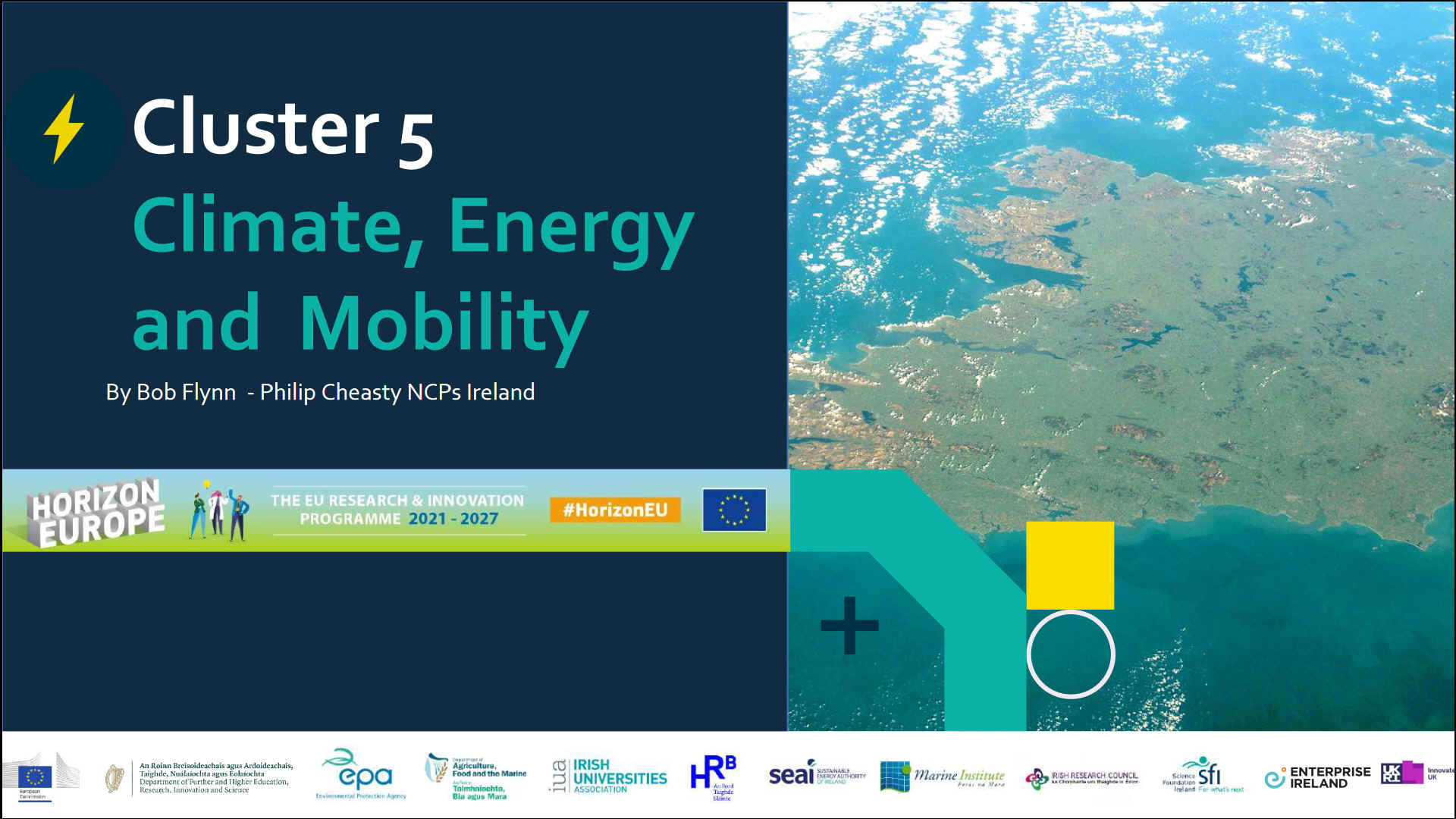
ENABLING
CLIMATE NEUTRAL, CLEAN, SMART, AND COMPETITIVE WATERBORNE TRANSPORT
The European Green Deal refers to the need to achieve clean, climate neutral shipping and waterborne operations and to the importance of research and innovation in this respect. Waterborne transport, in particular where large sea-going vessels are used, remains an important emitter of GHG and the sector needs to step up its efforts on a significant scale and through a wide range of measures. Within the
International Maritime Organisation (IMO) global agreement was reached in 2018 to cut total shipping GHG emissions by at least 50% by 2050 compared to 2008 (baseline). The EU considers this too timid and is committed to a much higher level of ambition. By the same date the Union aims to cut all transport emissions by at least 90%.
Even though the share of Inland Waterway Transport with regard to global GHG emissions is of minor importance the Central Commission for the
Navigation of the Rhine (CCNR) and its Member States take various steps to reduce the GHG emissions of the fleet. In 2018 the Mannheim Declaration was adopted which incorporates the EU GHG reducing targets for inland navigation and these efforts are supported through this work programme.
To provide the innovations needed to achieve the targets and show global leadership (also in pushing far more ambitious global regulatory standards) a new co-programmed European Partnership “Zero Emission Waterborne Transport” (ZEWT) will mobilise resources and leverage private and public investments towards the central objective of demonstrating by 2030 the deployable solutions needed for all main types of waterborne transport to become “net zero emission” by 2050 at the latest. Most topics on waterborne transport will contribute to the implementation of this partnership. Projects under ZEWT partnership topics are expected to provide up to two presentations on progress made to the ZEWT partnership members, also with the aim to support the monitoring of the ZEWT partnership performance as well the necessary underlying development to make these achievements possible within the time frame of the partnership.
Furthermore, in the context of the EU’s digital strategy “A Europe Fit for the Digital Age” the waterborne transport sector will have to embrace a wide-ranging digitalisation, resulting in new business patterns, smart ports, automation of shipping and cargo handling (which will provide higher efficiency and significantly safer operations), autonomous vessels, and new design and decision tools.
Topics on waterborne transport under this Destination of the cluster 5 work programme address climate neutrality and protection of the marine environment, digitalisation, and industrial competitiveness with the aim to support all pertinent EU policy objectives, also with regard to synergies with related programmes like the Connecting Europe Facility and the EU Innovation Fund.
The main impacts to be generated by topics targeting waterborne transport under this Destination are:
Increased and early deployment of climate neutral fuels and significant electrification of shipping, in particular and foremost in intra-European transport connections.
Increased overall energy efficiency and drastically lower fuel consumption of vessels (important in light of more expensive alternative fuels for which the sector will have to compete with other transport modes).
Enable the innovative port infrastructure
(bunkering of alternative fuels and provision of electrical power) needed to achieve zero-emission
waterborne transport (inland and maritime).
Enable clean, climate-neutral, and climate-resilient inland waterway vessels before 2030 helping a significant market take-up and a comprehensive green fleet renewal which will also help modal shift.
Strong technological and operational momentum towards achieving climate neutrality and the elimination of all harmful pollution to
air and
water.
Achieve the smart, efficient, secure and safe integration of maritime and inland shipping into logistic chains, facilitated by full digitalisation and
automation.
Enable fully automated shipping (maritime and inland) and efficient connectivity.
Competitive waterborne industries, including the globally active European maritime technology sector, providing the advanced green and digital technologies which will support jobs and growth in Europe.
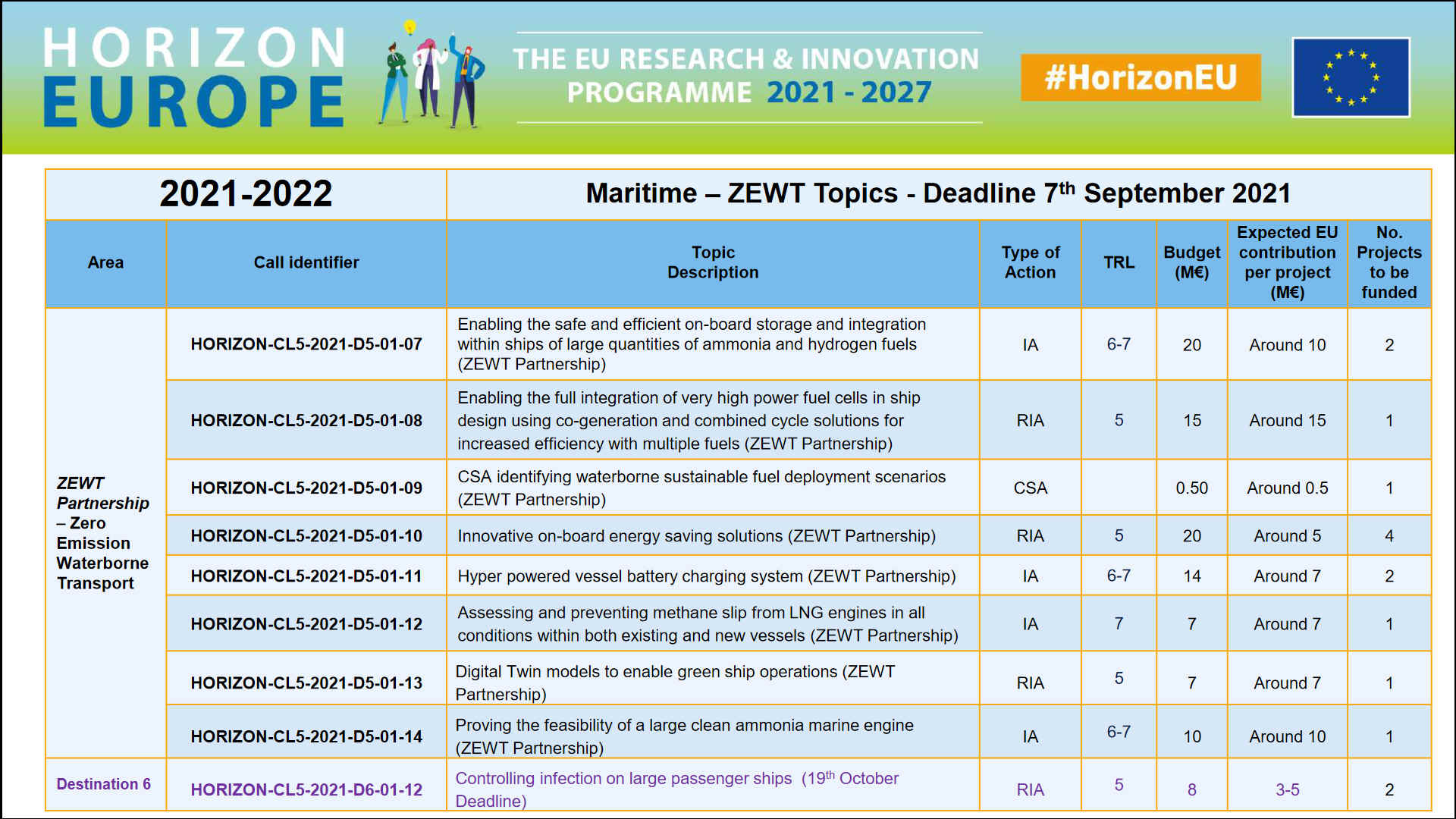
IMPACT
OF TRANSPORT ON ENVIRONMENT AND HUMAN HEALTH
Transport emissions are one of the main contributors to air quality problems, particularly in urban areas. At the same time, noise also negatively affects health. The World Health Organization (WHO) has classified traffic noise, including road, rail and air traffic, as the second most important cause of ill health in Western Europe, behind only air pollution caused by very fine particulate matter. Transport noise, particularly from road traffic, but also from rail and aviation, is a major contributor to noise pollution in urban areas. While type-approval noise limits for road vehicles, including their tyres, have been tightened over the years, the overall exposure to noise generated by road vehicles has not improved mainly due to increasing traffic volumes. L category vehicles are often perceived as a significant contributors to noise pollution and this might be due to the fact that noise emissions seem to be strictly optimised for specific conditions (but also due to tampering by their users, which in some cases is made too easy by the way the vehicles are built).
Electrification promises to address most of these issues, but as some transport modes are more difficult to electrify in the near future, there is need for research and innovation activities to develop appropriate and environmentally sustainable solutions. Furthermore, possible new pollutants and related health- challenges need to be monitored and investigated, and ways to deal with emissions by the existing fleet need to be studied and demonstrated.
The main impacts to be generated by topics targeting transport-related health and environmental issues under this Destination are:
- The better monitoring of the environmental performance and enforcement of regulation (detection of defeat devices, tampered anti-pollution systems, etc.) of fleets of transport vehicles, be it on road, airports and ports.
- Substantially reduce the overall environmental impact of transport (e.g.: as regards biodiversity, noise, pollution and waste)
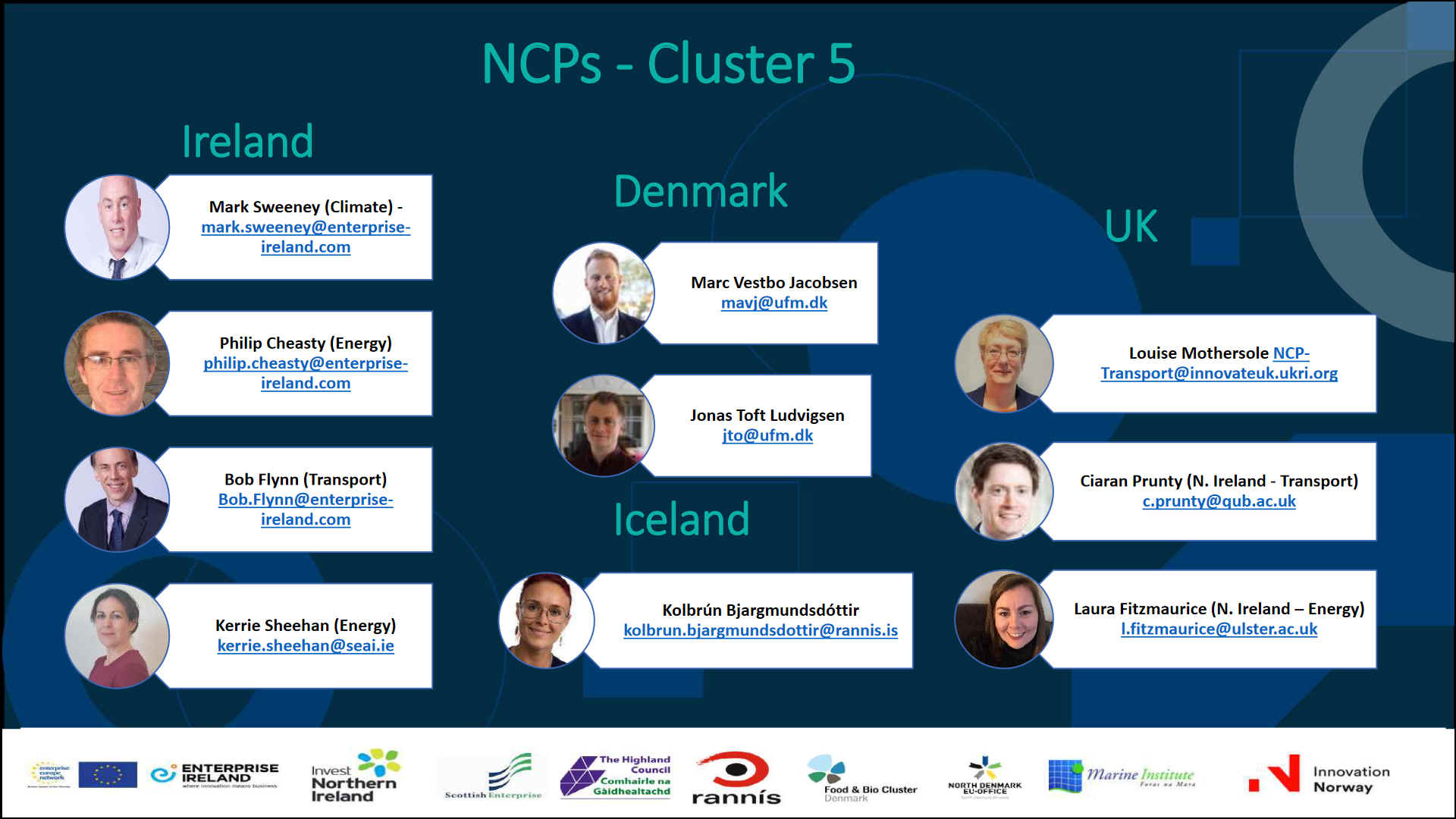
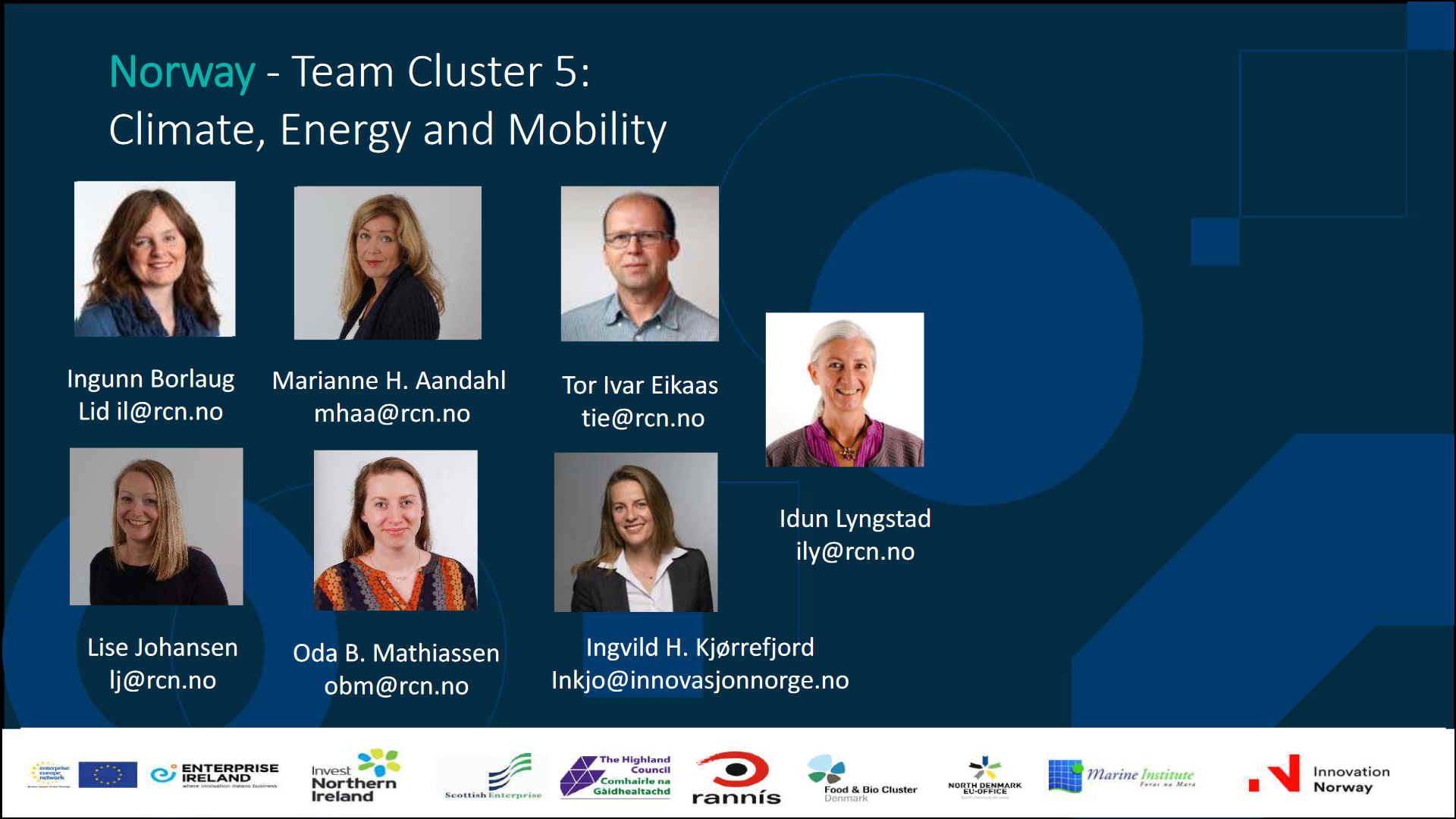
TOPIC CONDITIONS AND DOCUMENTS
General conditions
1. Admissibility conditions: described in Annex A and Annex E of the Horizon Europe Work Programme General Annexes
The page limit of the application is 70 pages.
Proposal page limits and layout: described in Part B of the Application Form available in the Submission System
2. Eligible countries: described in Annex B of the Work Programme General Annexes
A number of non-EU/non-Associated Countries that are not automatically eligible for funding have made specific provisions for making funding available for their participants in Horizon Europe projects. See the information in the Horizon Europe Programme Guide.
3. Other eligibility conditions: described in Annex B of the Work Programme General Annexes
4. Financial and operational capacity and exclusion: described in Annex C of the Work Programme General Annexes
5. Evaluation and award:
Award criteria, scoring and thresholds are described in Annex D of the Work Programme General Annexes
Submission and evaluation processes are described in Annex F of the Work Programme General Annexes and the Online Manual
Indicative timeline for evaluation and grant agreement: described in Annex F of the Work Programme General Annexes
6. Legal and financial set-up of the grants: described in Annex G of the Work Programme General Annexes
The funding rate is up to 60% of the eligible costs. This funding rate applies both to members and non-members of the partnership, except for non-profit legal entities, where the funding rate is up to 100% of the total eligible costs.
Specific conditions
7. Specific conditions: described in the specific topic of the Work Programme
DOCUMENTS
Call documents:
Standard application form — call-specific application form is available in the Submission System
The standard application form can be found in the link below, but be cautious that for this Call topic, the limit of 70 pages applies.
Standard application form (HE RIA, IA)
Standard evaluation form — will be used with the necessary adaptations
Standard evaluation form (HE RIA, IA)
MGA
HE General MGA v1.0
|
|
HORIZON MARITIME
Horizon Europe is the EU's next research and innovation programme starting in
2021, with the Green
Deal.
HORIZON-CL5-2021-D5-01-07
Enabling the safe and efficient on-board storage and integration within ships of large quantities of ammonia and hydrogen fuels (ZEWT
Partnership) IA to TRL 6-7 Budget €20m Around €10m
x 2 projects
HORIZON-CL5-2021-D5-01-08 Enabling the full integration of very high power
fuel cells in ship design using co-generation and combined cycle solutions for increased efficiency with multiple fuels (ZEWT Partnership) RIA
TRL 5 Budget €15 Around 15
projects @ €1m
HORIZON-CL5-2021-D5-01-09 CSA identifying waterborne sustainable fuel deployment scenarios (ZEWT
Partnership) CSA €0.50 Around 0.51
HORIZON-CL5-2021-D5-01-10 Innovative on-board energy saving solutions (ZEWT
Partnership) RIA 5 €20m Around €5m
for 4 projects.
HORIZON-CL5-2021-D5-01-11 Hyper powered vessel battery charging system (ZEWT
Partnership) IA TRL 6-7 Budget €14m Around 7
projects @ €2m
HORIZON-CL5-2021-D5-01-12 Assessing and preventing methane slip from LNG engines in all conditions within both existing and new vessels (ZEWT
Partnership) IA Budget €7
TRL 7 Around €7
for 1 project
HORIZON-CL5-2021-D5-01-13 Digital Twin models to enable green ship operations (ZEWT
Partnership) RIA TRL 5 Budget €7m Around 7
projects A@ €1m
per project
HORIZON-CL5-2021-D5-01-14 Proving the feasibility of a large clean ammonia marine engine (ZEWT
Partnership) IA TRL 6-7 Budget €10m Around 10
projects @ €1
HORIZON-CL5-2021-D6-01-12 Controlling infection on large passenger ships (19thOctober
Deadline) RIA Budget €8 €3-5 for 2 projects (Destination 6)
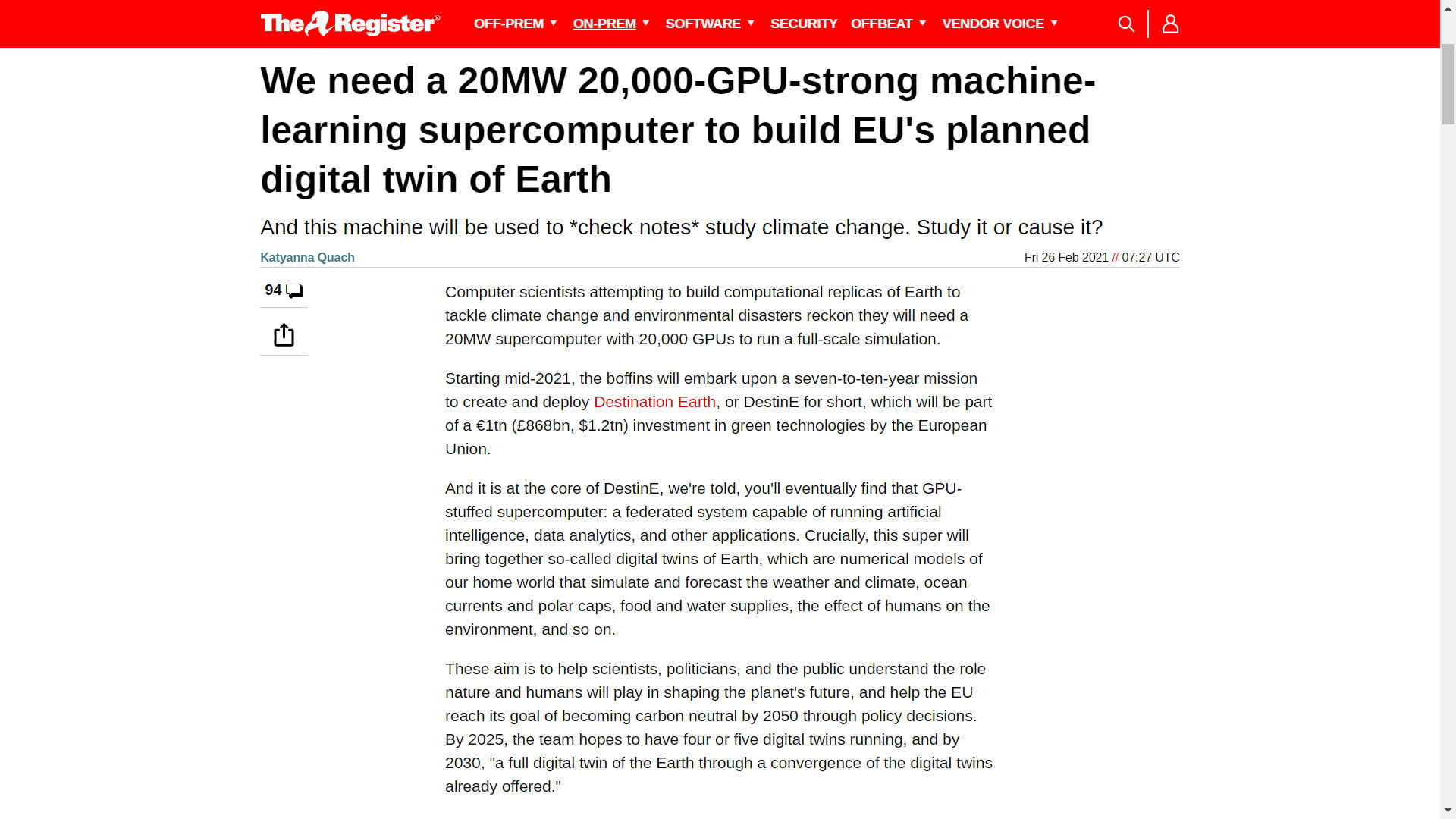
REGISTER 26 FEBRUARY 2021 - We need a 20MW 20,000-GPU-strong machine-learning supercomputer to build EU's planned digital twin of Earth. And this machine will be used to *check notes* study climate change. Study it or cause it?
Computer scientists attempting to build computational replicas of Earth to tackle climate change and environmental disasters reckon they will need a 20MW supercomputer with 20,000 GPUs to run a full-scale simulation.
Starting mid-2021, the boffins will embark upon a seven-to-ten-year mission to create and deploy Destination Earth, or DestinE for short, which will be part of a €1tn (£868bn, $1.2tn) investment in green technologies by the European Union.
And it is at the core of DestinE, we're told, you'll eventually find that GPU-stuffed supercomputer: a federated system capable of running artificial intelligence, data analytics, and other applications. Crucially, this super will bring together so-called digital twins of Earth, which are numerical models of our home world that simulate and forecast the weather and climate, ocean currents and polar caps, food and water supplies, the effect of humans on the environment, and so on.
These aim is to help scientists, politicians, and the public understand the role nature and humans will play in shaping the planet's future, and help the EU reach its goal of becoming carbon neutral by 2050 through policy decisions. By 2025, the team hopes to have four or five digital twins running, and by 2030, "a full digital twin of the Earth through a convergence of the digital twins already offered."
"If you are planning a two-metre high dike in The Netherlands, for example, I can run through the data in my digital twin and check whether the dike will in all likelihood still protect against expected extreme events in 2050," said Peter Bauer, deputy director for Research at the European Centre for Medium-Range Weather Forecasts (ECMWF) and co-initiator of Destination Earth initiative, this week.
Computer scientists will be able to tweak the digital twins to assess hypothetical scenarios, such as the outcome of adding wind farms in various locations across Europe or where crops should be best grown in the future as conditions change. The DestinE team wants to map all the processes unfolding on Earth’s surface, and be able to inspect the model down to a kilometre by kilometre scale. In order for the digital twins to be accurate recreations, they will need to ingest data from numerous sources.
“First and foremost, a digital twin would become a data assimilation instrument that continuously cycles real-time, highly detailed, high-resolution Earth system simulations and ingests observational information from all possible instruments — including novel observatories like miniaturized satellites, drones in the
Arctic, undersea cables and buoys, smart sensor arrays in crop fields and mobile phones within the expanding internet of things — also to estimate uncertain model parameters and surrogate missing process details,” states a paper describing the project published in Nature.
The sheer amount of data from these instruments and devices will require a non-trivial level of compute to process, Bauer and his colleagues at the ECMWF and ETH Zurich warned in a second study also published in Nature.
MORE POWER!
The team figured primarily GPU-accelerated machines are the way to go versus purely CPU or a balance of CPU-GPU. After weighing up benchmarks, and considering what technology will be developed in the near future, they believe to run a full-scale digital twin of Earth, they will need something four times the scale of today's Piz Daint 25-plus petaFLOPS supercomputer, which has 5,000 Nvidia Tesla P100 GPU accelerators.
“Extrapolating this to near-future technology produces an estimate of a remaining shortfall factor of four thus requiring about 20,000 GPUs to perform the digital-twin calculations with the necessary throughput,” they wrote. “This machine would have a power envelope of about 20MW.”
For comparison, America's 10MW Summit, the second most-powerful-known super listed in the latest top 500 rankings, has a peak theoretical performance of about 200 petaFLOPs and today sports more than 27,000 Nvidia Tesla V100 GPUs. It was built by IBM for the Oak Ridge National Laboratory.
The irony of building an energy-intensive system to tackle climate change was not lost on the researchers. They noted in their paper that the future super should be built at a location where its nodes can run on more renewable energy sources: “According to the US Environmental Protection Agency, which accounts about 1,000 lb CO2 output per MWh, such a simulation machine, if it was built in places where only ‘dirty’ power is available, would produce substantial amounts of CO2 per year.”
In order to keep the digital twin running as efficient as possible, the model’s software will need to be boosted by machine learning, we're told. The boffins believe that it will require a mix of traditional climate modelling techniques and AI algorithms to operate the various physical models. It's likely neural networks will deal with processing the incoming data and crunching it before it is passed onto the mathematical models.
“The majority of the weather and climate community remains skeptical regarding the use of black-box deep-learning tools for predictions and aims for hybrid modeling approaches that couple physical process models with the versatility of data-driven machine learning tools to achieve the best results,” the study noted.
|
